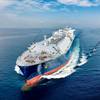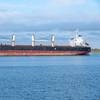The MAN B&W Diesel Group will supply a total of ten 12V48/60B Diesel engines to the Meyer Werft, Germany for two cruise vessel newbuildings of Norwegian Cruise Line (NCL), Miami. The first five diesel engines, each with 14,400 kW (19,600 hp), will be delivered to Papenburg, Lower Saxony, in July, the remaining engines will be supplied in April 2005.
These engines are equipped with IS (Invisible Smoke) technology, which means that the exhaust gas is invisible within the operated load range. This product feature is vital for cruise vessels. In addition, the MAN B&W engines are provided with a particularly environmentally friendly nitrogen-oxide reduction technology, which is obtained by fuel-water emulsion (FWE). Water injection into the combustion chamber reduces temperature peaks and results in a clearly lower nitrogen oxide content in the exhaust gas. The MAN B&W Diesel Group is not only leading in the field of FWE technology development but looks back on many years of practical experience.
With these new buildings, each of which offers room for 2,400 passengers, NCL realizes the successful and innovative freestyle cruising concept: Guests are welcome to 10 restaurants, an ample fitness and spa centre, a night club, theatre, casino and conference rooms. With regard to vessel propulsion, NCL focuses on the new version of the successful 48/60B medium-speed engine series produced by the MAN B&W Diesel Group. Based on the successful 48/60 type, of which some 300 engines have been sold, a further developed version was designed in accordance with the latest Diesel technology. Almost every essential feature has been improved without any adverse effect on the well-known robustness of this engine series.
This new development is, in particular, characterized by reduced pollutant values and lower consumption rates.
Among other things, the shape of the combustion chamber was optimised and the compression ratio increased. The minimum fuel consumption amounts to 173 g/kWh, which is 7 g/kWh less, compared to the 48/60 series. The emission value of the IMO NOx test cycle amounts to 12 g/kWh, which means a reduction of 8 percent as against the predecessor. Should the FWE system be used, this value is even considerably lower.
Subscribe for
Maritime Reporter E-News
Maritime Reporter E-News is the maritime industry's largest circulation and most authoritative ENews Service, delivered to your Email five times per week










